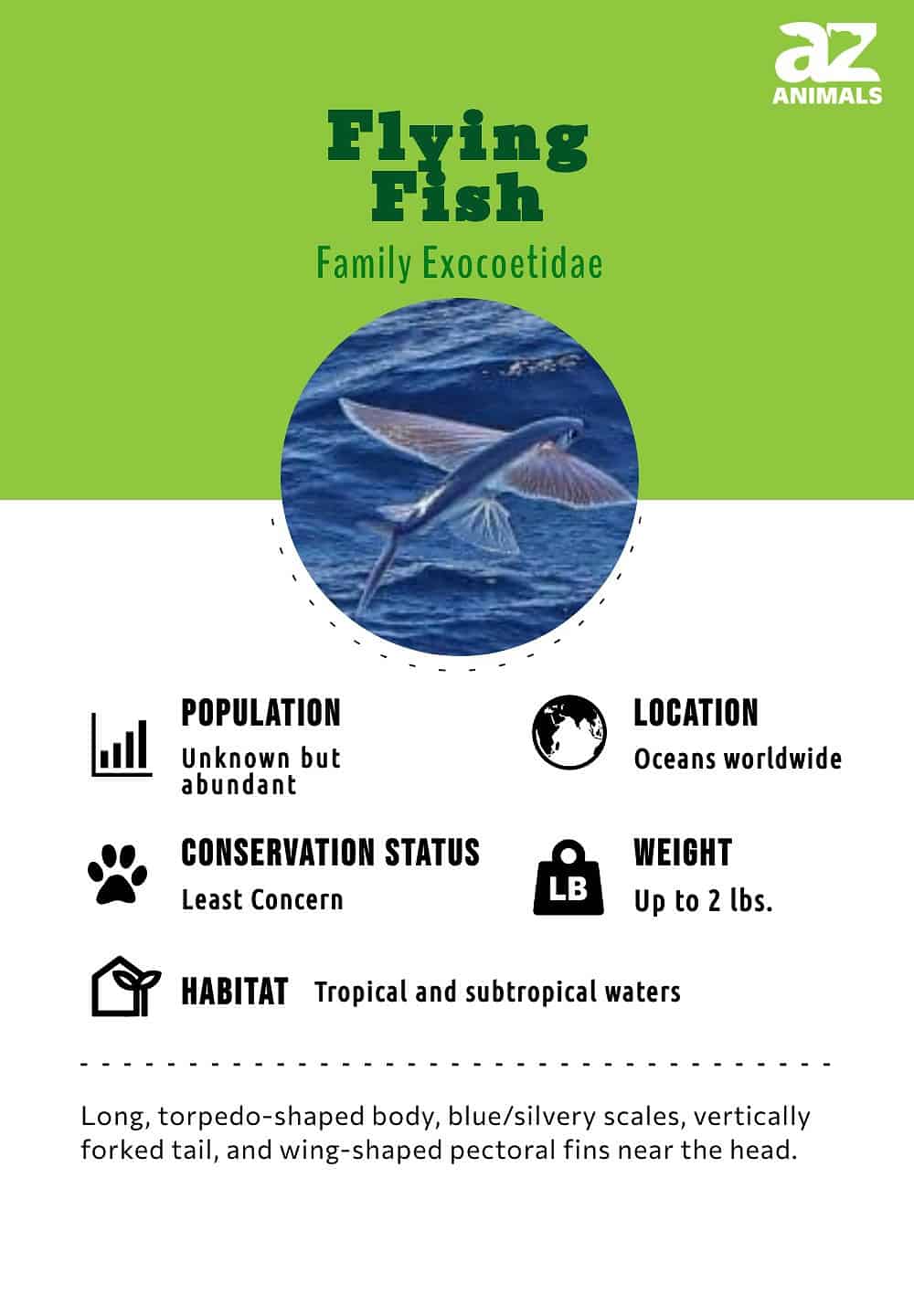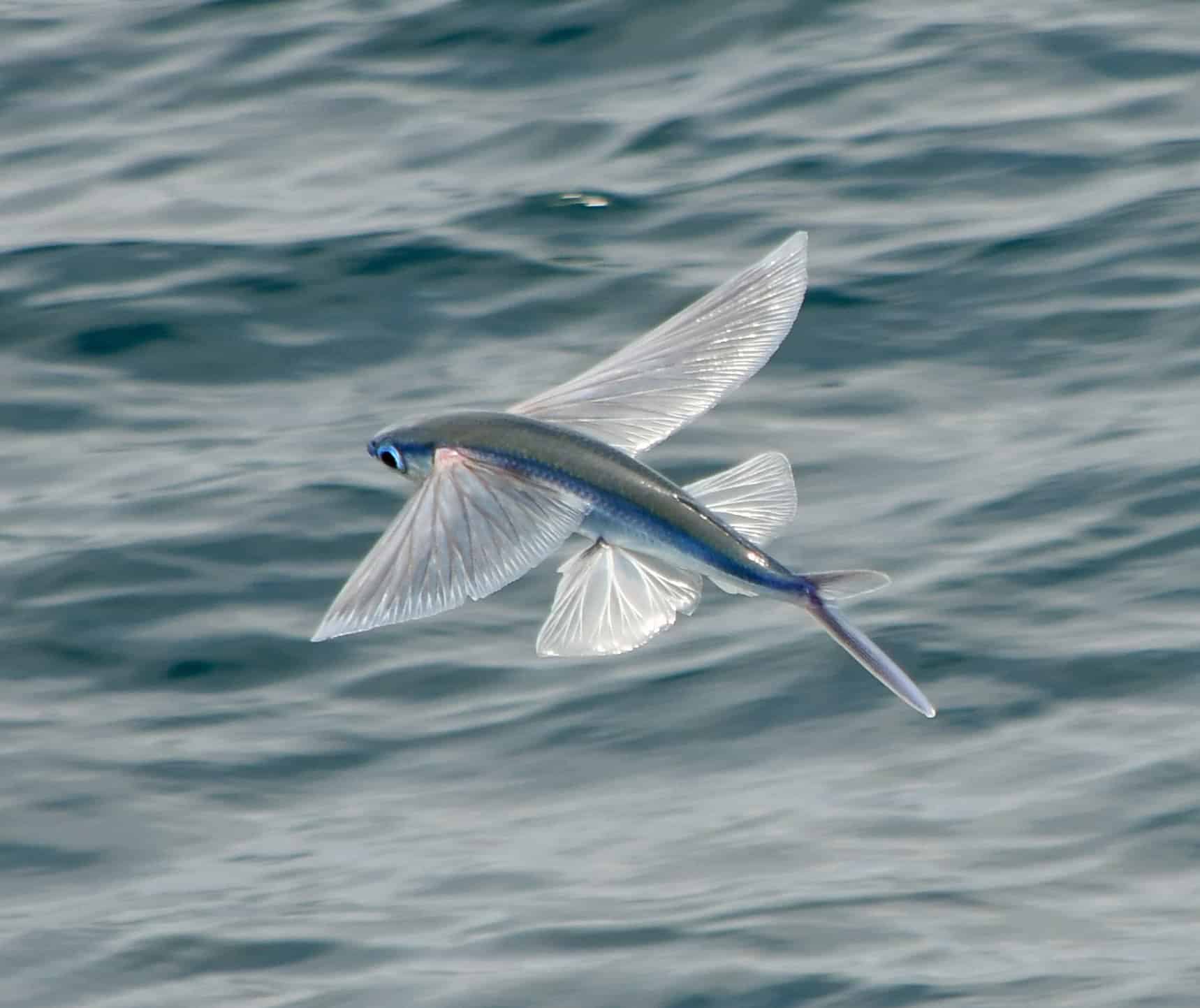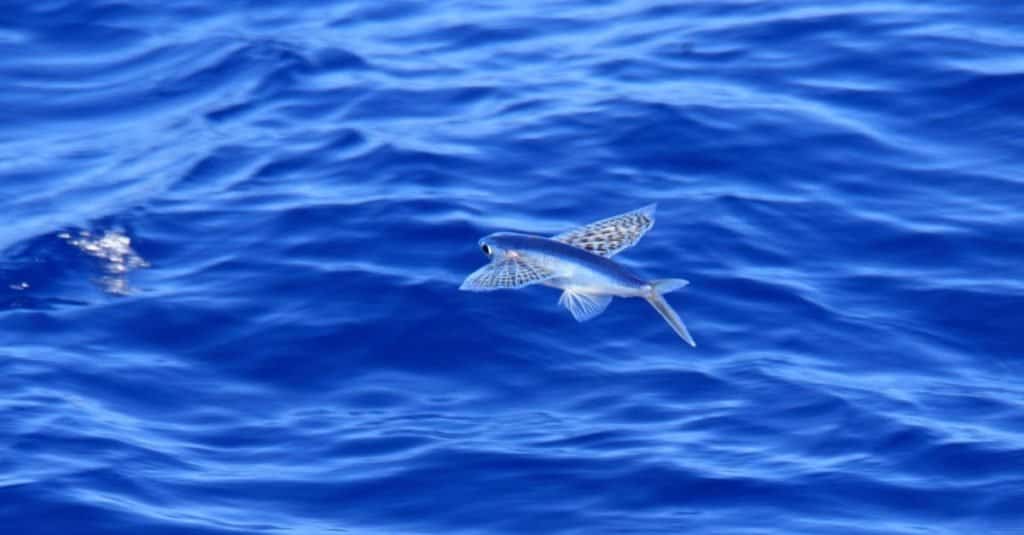Flying Fish
Can glide in the air for hundreds of feet
Advertisement
Flying Fish Scientific Classification
Read our Complete Guide to Classification of Animals.
Flying Fish Conservation Status
Flying Fish Facts
- Prey
- Plankton, crustaceans, and fish
- Group Behavior
- School
- Fun Fact
- Can glide in the air for hundreds of feet
- Estimated Population Size
- Unknown
- Biggest Threat
- Overfishing
- Most Distinctive Feature
- Wing-like fins
- Other Name(s)
- Flying cod
- Gestation Period
- Varies
- Habitat
- Oceans
- Predators
- Marlins, tuna, squid, porpoises, birds, and humans
- Diet
- Omnivore
- Type
- Ray fin fish
- Common Name
- Flying fish
- Number Of Species
- 40
View all of the Flying Fish images!
The flying fish, also known as a flying cod, is a family of ray fin, marine fish, common to warm, tropical waters throughout the world’s oceans.

The Flying Fish has a remarkable ability that sets it apart from any other fish in the world: its pectoral fins are highly modified “wings” that enable it to leap out of the water and glide above the surface for up to 650 feet (and potentially twice that length with a good gust of wind). The flying fish travel together through the oceans in large schools. When they encounter a predator, the wings help them make a hasty escape. Some flying fish have been recorded performing 12 consecutive flights. This family of fish is quite abundant around the world; very few species are endangered.
5 Incredible Facts!
- While the vast majority of these fish have two “wings,” some species have up to four. Both their pelvic and pectoral fins are shaped into wings.
- For some unknown reason, these fish appear to be attracted to sources of light. Fishers will use this knowledge to catch enormous numbers of flying fish at once.
- The fish swim toward the surface of the water at a rate of 3 feet per second. In order to launch themselves into flight, they beat their tails rapidly about 70 times a second and hold their fins close to their bodies. Upon breaking the surface of the water, they extend their wings and start to glide.
- Some of these fish migrate hundreds of miles throughout the year, depending on the availability of food. However, climate change may be altering their usual migratory routes.
- According to the fossil record, the modern flying fish evolved some 66 million years ago. But a separate group of flying fish, now extinct, may have first evolved more than 200 million years ago.
Classification and Scientific Name

The Flying Fish is a member of the Family Exocoetidae, which means “sleeping outside.”
©Brent Barnes/Shutterstock.com
The scientific name for the family of ray fin, flying fish is Exocoetidae. This is a combination of two Latin words that roughly translate to “sleeping outside.” The name is based on a misconception from early sailors that these fish returned to the shore at night to sleep. These fish belong to the order of Beloniformes, along with needlefish and ricefish.
Species
The family of flying fish is composed of approximately 40 species spread out across 7 or so genera. Here’s a list of just a few of them. In addition, pictures of the Yellow-wind and the Gurnard flying fish appear below.
- Blue Flying Fish: Also known as the tropical two-wing flying fish, this species is found throughout much of the tropical waters of the Atlantic and Pacific. The upper half of the body is an iridescent blue and the stomach is a silvery-white color.
- Black Wing Flying Fish: This species is also found throughout most of the tropical Atlantic and Pacific. It is distinguished by the dark blue, almost purple upper half, which complements the white lower half.
- Four-wing Flying Fish: As the name suggests, this species has four “wings” instead of two. Commercial rights for this species of fish are important enough to have caused a dispute at one time between the Caribbean countries of Barbados and Trinidad and Tobago.
Appearance

This
Yellow-wing flying fish (Cypselurus poecilopterus) in Japan shows the second set of wings that some flyiing fish have.©feathercollector/Shutterstock.com
The flying fish looks a bit like a sardine (though not really like a cod). It has a long, torpedo-shaped body, blue or silvery scales, and a vertically forked tail. By far the most prominent features are the wing-shaped pectoral fins near the head that enable them to glide through the air. Some species also have a second set of “wings” that are really just modified pelvic fins. The medium-sized fish can measure anywhere between 6 and 20 inches in length but never exceed 2 pounds in size.
Distribution, Population, and Habitat
These fish are found all throughout the world’s three major oceans (the Atlantic, Pacific, and Indian), up to a depth of around 650 feet. Most species tend to concentrate in tropical and subtropical waters. They are very rare up north because colder temperatures appear to impede the muscular function necessary to glide through the air.
The flying fish is so common around the Caribbean that it is actually the national symbol of Barbados. Although it is sometimes popular in the commercial fishing industry, population numbers appear to be quite high and stable. Almost all species are classified by the IUCN Red List as least concern. Very few are endangered.
Flying Fish Predators and Prey

This Flying Gurnard fish is swimming underwater over a sandy seabed where it could be prey to birds or humans.
©Damsea/Shutterstock.com
The flying fish are an integral part of the food chain in many tropical marine environments around the world. They acquire nutrients from smaller prey and provide nutrients to larger predators farther up the food chain. These fish are preyed upon by marlins, tuna, squid, porpoises, birds, and humans. They themselves are omnivores, so although the bulk of their diet consists of plankton, they also sometimes consume small crustaceans and fish.
Reproduction and Lifespan
These fish will congregate by the millions each year for the spawning season. This occurs near the surface of the open ocean. The female will release hundreds of eggs into the water for the male to fertilize (these eggs can be eaten by people as edible roe). She will then attach her fertilized eggs via a sticky filament to a piece of seaweed or floating debris.

A flying fish, largely on its own after birth, gains the ability to fly after reaching about two iinches in length.
©Daniel Huebner/Shutterstock.com
After a few days, the fish are born with whiskers near their mouths to help them blend in among the plants. From the moment of their birth, they are largely on their own, and many will end up perishing from predators. They gain the ability to fly after reaching about two inches in length. The average lifespan of these fish is approximately five years.
Fishing and Cooking
The flying fish are considered to be quite an edible meal. It is commercially caught on a large scale throughout the entire Asia Pacific region and parts of the Caribbean. The most common methods of fishing are gillnetting (vertical nets that hang from a line) or dipnetting (a large scoop held in place by a hoop).
The fish are fried, steamed, and even made into sushi. In Barbados, they are thought to go well with cou-cou, the national dish of cornmeal and okra. The roe (the eggs) is also considered a delicacy in several countries. Many people claim that the flying fish has a firm, savory taste.
View all 91 animals that start with FFlying Fish FAQs (Frequently Asked Questions)
Where are flying fish found?
Flying fish are found in warm and sometimes temperate waters of the Atlantic, Pacific, and Indian Oceans.
What does a flying fish eat?
Flying fish eat plankton, crustaceans, and smaller fish.
Where do flying fish live?
Flying fish live in the open ocean and sometimes near coral reefs close to the surface.
What is a flying fish?
The flying fish is a family of marine animals with wing-shaped fins that enable them to glide briefly above the surface of the water. This behavior is so peculiar that no other type of fish can claim to have it. Otherwise, they look and behave similarly to conventional fish. They are quite abundant, and very few species are endangered.
Do flying fish actually fly?
Flying fish cannot flap their wings like birds to gain altitude. Instead, they use their momentum in the water to launch in the air and then glide over distances of hundreds of feet.
How long can flying fish stay out of water?
The longest amount of time a flying fish was ever recorded in flight was about 45 seconds. They cannot breathe the air, so their ability to glide is necessarily limited.
Why do flying fish exist?
The gliding ability is an adaptation that probably evolved to help the fish escape ocean predators. However, this also came with a small downside: it made them more vulnerable to birds.
What does flying fish taste like?
The flying fish is supposed to have a firm, savory taste. The roe is also quite edible.
Thank you for reading! Have some feedback for us? Contact the AZ Animals editorial team.
Sources
- National Wildlife Federation, Available here: https://www.nwf.org/Educational-Resources/Wildlife-Guide/Fish/Flying-Fish
- Live Science, Available here: https://www.livescience.com/flying-fish.html

















